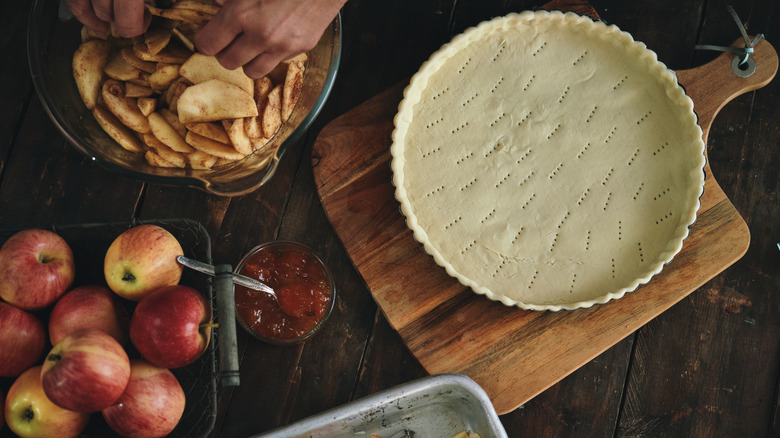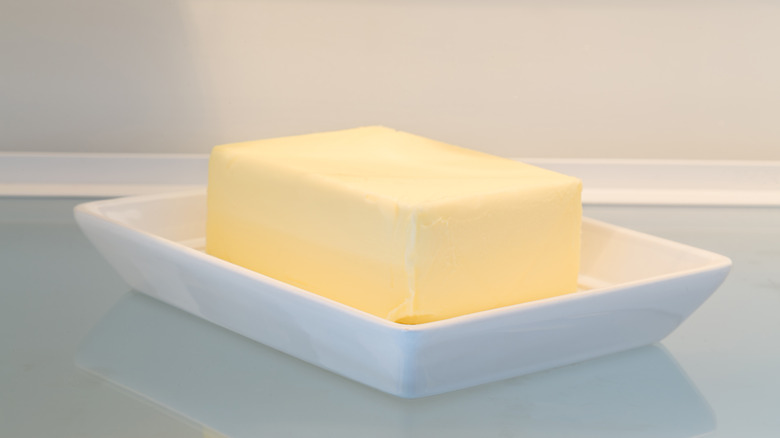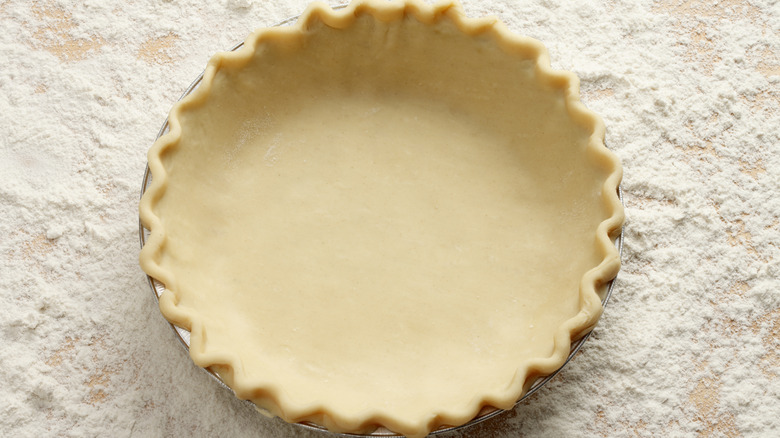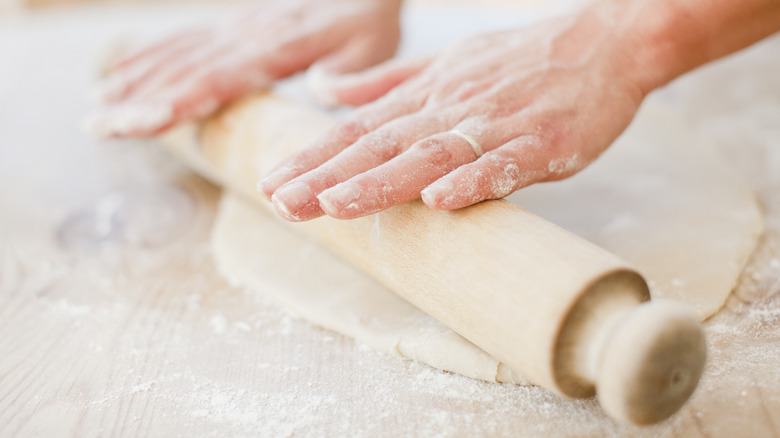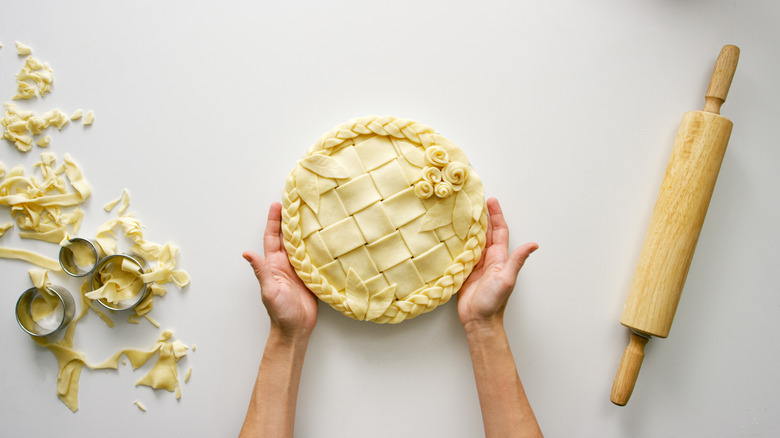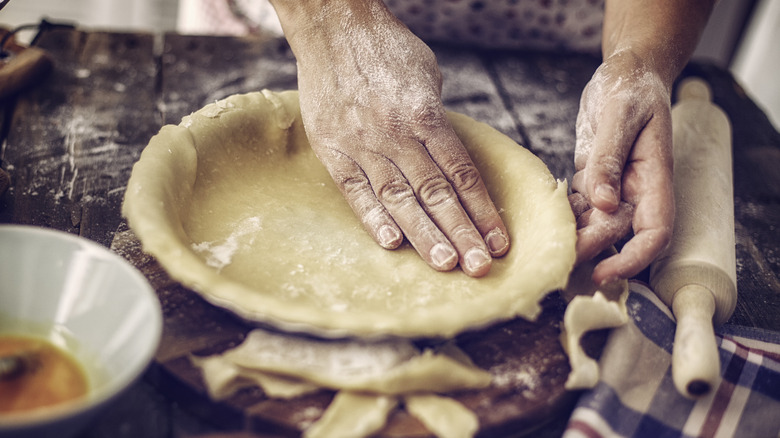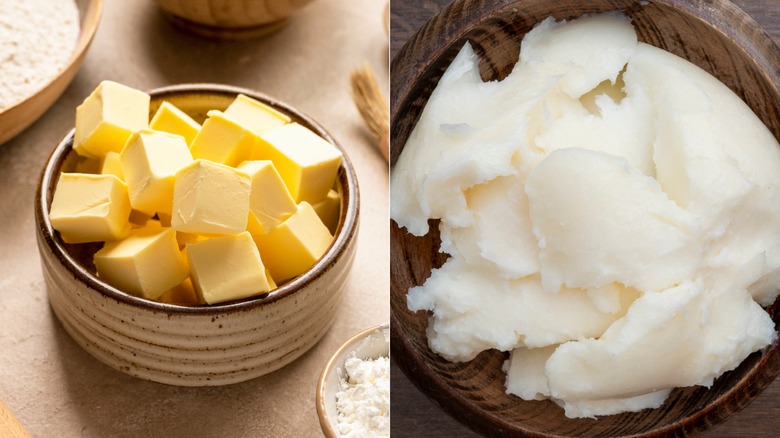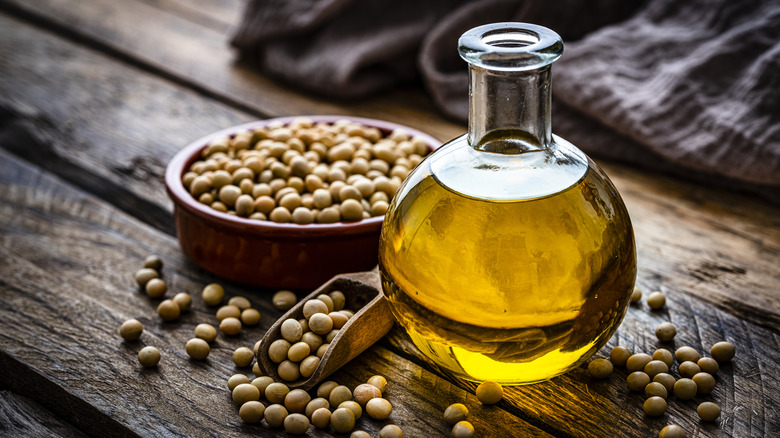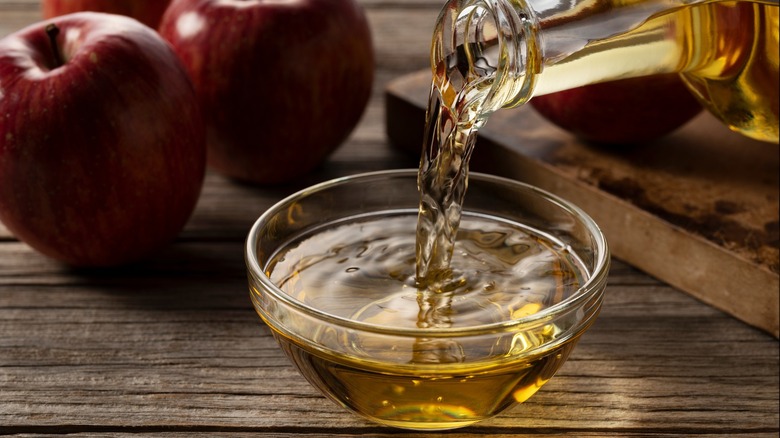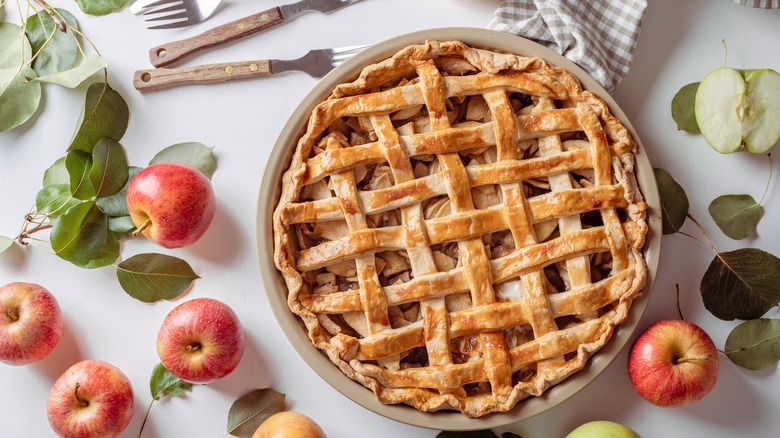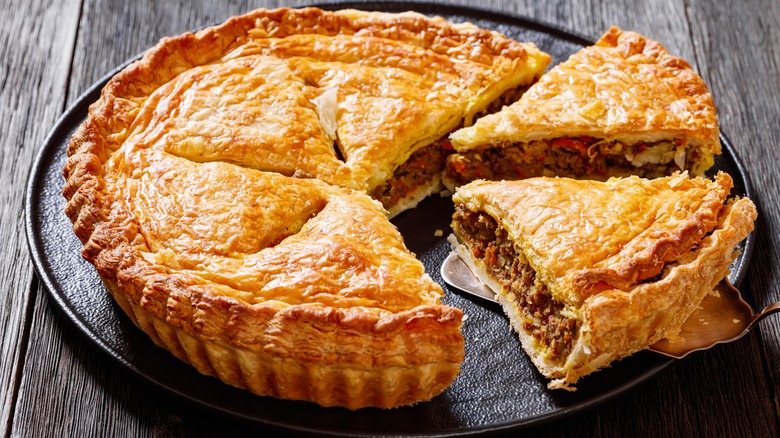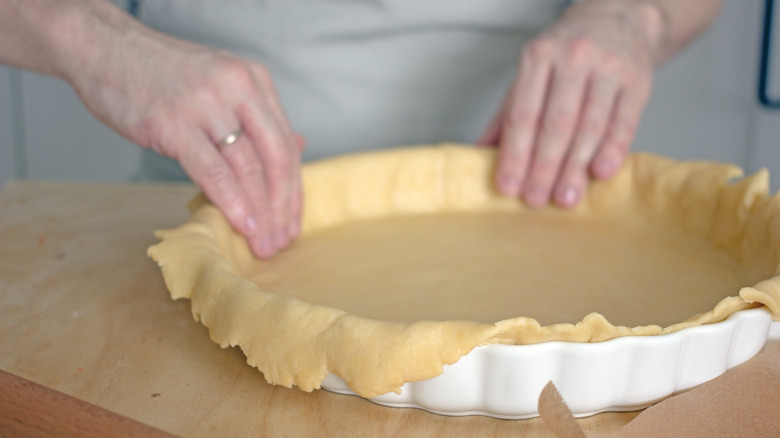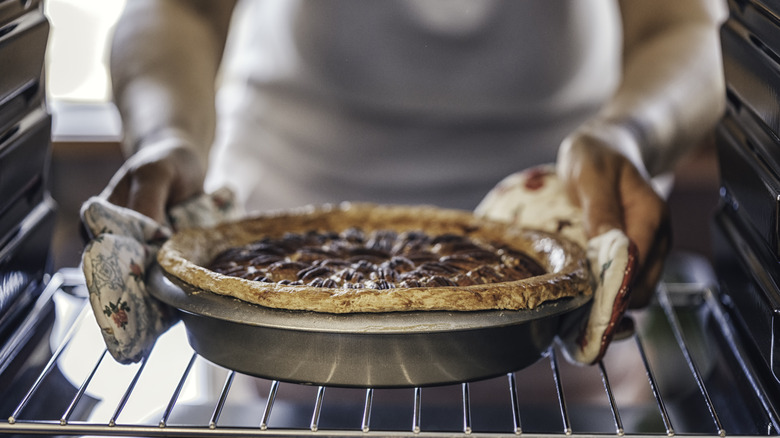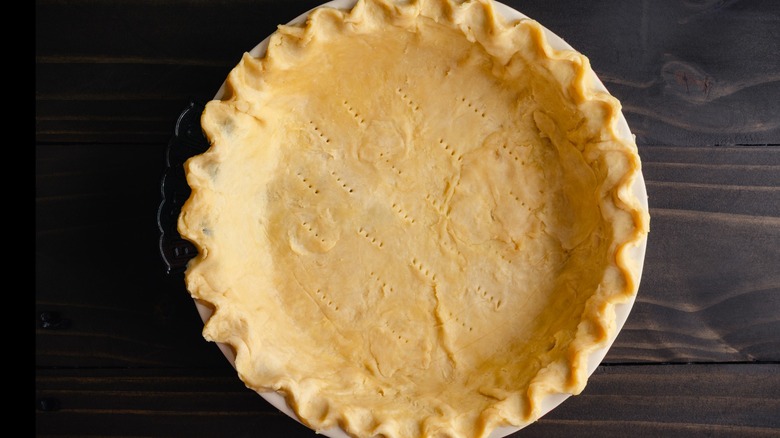13 Pro Tips For Making A Perfect Pie Crust Every Time
It's no secret that there's a lot to love about Thanksgiving dinner. Whether you are a fan of the stuffing, the mashed potatoes, or the classic roast turkey, Thanksgiving is the one time of year that you can really get your fix — and even top it with some steaming hot gravy. At the end of the meal, though, there's one thing that a whole lot of people look forward to: The pie. And, for party hosts, this means that it's essential to get both the recipe and preparation right.
Of course, I myself am no stranger to this pressure. Over the years, I've made more than my share of pies — always with a homemade crust out of my personal belief that desserts are worth every ounce of extra effort. Unfortunately, though, that doesn't mean that all of my pie crust attempts have been equally fruitful. My worst moment? Probably the time that my rolled-out pie dough stuck to the kitchen counter, leaving me to transfer it to the mold piece-by-piece like a patchwork quilt. Next in line? The time a "little kitchen helper" vigorously stirred the dough when I wasn't looking. The crust came out rock-hard.
This year, I'm determined not to let history repeat itself so I have extensively researched the ways real professionals make the perfect pie crust. Taking expert advice from bakers, pastry chefs, and celebrity cooking stars, I've compiled a list of some of the best tips out there.
Keep your ingredients cold
A freshly baked apple pie may taste incredible when piping hot, but when it comes to making a pie crust, cold is your magic word. At least, that's according to the renowned cookbook author and television host, Chef Jean-Pierre. On his YouTube channel, the culinary professional shares the ins and outs of making the perfect pie crust. The way he sees things, the colder your ingredients are before combining them, the better.
Speaking on this, Jean-Pierre explained, "The butter, my friends, has to be very very very very cold, okay? Like, super super cold." Later, he added, "We're going to put two very very cold eggs." Interestingly, the chef considers this an essential aspect of the pie-making process. "Everything is very cold. That's the secret. Very simple, eh?"
While this advice may sound odd at first, there's science to back Jean-Pierre's advice. As explained in the book, "Cooking for Geeks" by Jeff Potter, "Chilling the ingredients prevents the butter from melting, which would allow the water in the butter to interact with the gluten in the flour, resulting in a less-flaky, more bread-like dough" (via Quartz). In practice, this means that cooling your ingredients before using them can help guarantee that your pie crust will have that nice and light consistency.
Make your dough in advance
If you are worried about making sure that your pie dough is cold enough to work with, you might want to look to Melissa Weller for advice. Weller, a professional pastry chef, trained at New York City's iconic Babbo and Sullivan Street Bakery before releasing a killer cookbook titled "A Good Bake." Her method to keep your pie crust cool? Just put the dough in the fridge before rolling it out.
As Weller suggested in an article for Bon Appétit, make your pie dough — and store it in your ice box — well before you plan on actually baking your pie. Not only will this ensure the flakiness of your crust, but it will also make the dough easier to work with. Weller explained, "Chilled dough with relaxed gluten will simply be easier to roll out." Apparently, this will also allow the crust to bake more easily. In the words of the pastry chef herself, "Making the dough in advance gives the gluten time to relax, which prevents shrinkage in the crust when baked." As an added bonus, Weller says you can prepare your pie crust up to a month in advance. This will give you plenty of time to plan your baking around your busy schedule.
Don't over-handle the dough
When making cakes or other baked goods, stirring your ingredients thoroughly is considered essential. When making a pie crust, however, the opposite is true. As professional baker Zoe Denenberg explained in a piece for Southern Living, over-handling your dough can be a major mistake. "When handling your pie dough, use a delicate touch. We aim to mix all the ingredients until just combined, not to mash them into a thoroughly blended lump," she wrote.
Fascinatingly, there's science behind Denenberg's advice too. The longer that you handle the dough, the more likely it is that your once-chilled ingredients will heat up and soften the butter. This, in turn, increases the odds that gluten will start to develop in your dough, giving you a chewy pie crust. For this same reason, Denenberg advises against holding the dough for prolonged periods in your hands. After all, if the warmth in your palms melts the butter, your crust could be ruined, so kneading the dough for more than a few seconds is just too risky. Instead, try to mix it lightly and loosely with your hands.
Avoid fancy pie-making equipment
These days, home goods stores are packed with nifty tools, with each one claiming to be better than the other. Because of this, it can be tempting to buy specialized tools for pie-making, whether that may be a marble rolling pin or a special food processor. While there's nothing inherently wrong with using any of these tools in your pie-making process, there is one major name that warns against making things too complicated in the kitchen. And it's the legendary Martha Stewart, so we're taking her tips pretty seriously!
According to Stewart's official website, the perfect pie crust is not exactly machine-made: "A few simple ingredients are mixed by hand — no need to dirty the food processor — to make perfect pie dough with minimal cleanup."
Although the celebrity chef did not give any reasons for her preference, one possible explanation could be the necessity of feeling the dough to check if it's getting too warm. As Stewart recommended later in the same article, "If the dough starts to feel warm or sticky at any point when you're rolling it out, pop it back in the refrigerator for a few minutes until it is cool to the touch." In that sense, using your hands gives you greater control over how your crust is going to turn out.
Pay attention to your pie crust's thickness
One of the main benefits of making a pie crust with your hands is that it allows you to control the thickness of the crust. Depending on what type of pie you're making, you might want the crust to be anywhere from robust to quite thin. As chef Nancy Silverton told the outlet Yes Chef, "Most American-style pies require a thicker crust. A French tart or pâte brisée recipe, on the other hand, can be rolled fairly thin." To make sure that you get the thickness right, Silverton suggests pounding the dough with your hands prior to rolling it out. In her view, this will help you get the dough fairly close to the thickness that you're after before you whip out your rolling pin.
Even if you are going to attempt a thinner crust, it's generally okay to make a crust that's a little bit thicker than what the recipe calls for. Speaking with Food52, baking consultant Erin McDowell advised home cooks against making the crust too thin, warning that otherwise, you could end up with a breakable crust.
Source quality butter or lard
When it comes to selecting your ingredients, you may feel torn about choosing butter or lard. Newer recipes tend to recommend the first option, while the old-fashioned ones tend to go for the second. Whether you consider yourself a traditionalist or more of a modern baker, you really can't go wrong. As baking pro Melissa Weller revealed in a piece for Bon Appétit, "Many traditional American pie dough recipes call for lard, which is rendered pork fat and makes for a flakier crust." However, lard won't give your crust that "that great buttery flavor."
In that sense, choosing butter versus lard doesn't matter as much as the quality of the ingredients that you choose. Reaching for a nice block of, say, hand-crafted French butter rather than your average supermarket fare can make a huge difference in terms of the intensity of your pie crust's flavor. The same goes for lard. Of this traditional ingredient, Weller wrote, "I love it, but quality lard is not always easy to find, so I use good old-fashioned butter to make my pie and tart crusts."
If you do opt for butter, try to use the unsalted kind. According to Martha Stewart's personal blog, this will allow you to determine just how salty you want your crust to be: "You can always add more salt to a dish, but if you use salted butter, you can't remove it if the dough is too salty."
Add a bit of vegetable oil
Regardless of whether you choose to add lard or butter to your pie crust, there's one other fatty ingredient that can actually make a huge difference in your recipe — vegetable oil. According to celebrity pastry chef Anna Olson, you can use this element in addition to lard or butter. This is a great way to prevent your flour from mixing too much with the other fat components. As Olson explained on YouTube, "I've come across a new technique that ensures that your butter will not overmix into the flour. What I do is I first add three tablespoons of vegetable oil."
The reason that this works is that the oil provides a barrier between your flour and the butter or lard. According to Olson, "Stirring the oil into the flour evenly coats the flour. So now, the flour is insulated and protected, and won't absorb all the butter."
Try substituting water with apple cider vinegar
Most pie crust recipes have very few components — usually some combination of ice water, butter, flour, and sometimes eggs. Although this typically leaves very little room for secret ingredients, Greg Rales of New York City's Red Gate Bakery makes one substitution that seems to work really well. As the professional chef and baker shared in an interview with Forbes, he switches out about a quarter of his ice water for apple cider vinegar. Rales explained, "I'm not sure the science of adding acid to pie crust to increase flakiness actually bears out, but regardless of that, the vinegar adds a slight tang in flavor that I quite enjoy."
Compellingly, the science behind this is that adding an acidic ingredient to your crust can affect the way gluten forms, and the yet-to-be-proven theory says that this can make it flakier. As Marta Stewart's blog puts it, "The acidic properties of vinegar inhibit gluten, some will say. This theory proposes that once the water and flour are combined, gluten starts forming, causing the dough to grow tough. Adding an acid, the theory goes, stops the gluten in its tracks and rescues the crust from toughness." While this idea hasn't been confirmed in a lab, several famous bakers use it to guarantee the quality of their crust. The way we see it, it's at least worth a try.
Patience makes perfect
Thanksgiving dinner is not always the easiest meal to prepare and, because of this, it can be tempting to rush through the steps. Slapping a few ingredients together, throwing a crust into a pan, and shoving some sliced apples inside may sound easy, but your pie crust will only taste as good as the time you have invested into it.
According to Jeremy Intille, who works as a pastry chef at the Fitler Club, this means that you need to be as patient with your pie as possible. Speaking to Forbes, he confessed, "My woo-woo tip [is that] the energy you have while making food is the energy it takes on ... Pastry is the art of patience, [so] don't rush your pie." Apparently, home cooks who try to go through the steps too quickly can easily end up with a disaster on their hands. "Shortcuts will never make for a better product," Intille observed. Instead, he suggested, "Practice, adjust recipes to suit your needs and practice some more. Have fun, you're making a delicious treat for yourself or to share with others, enjoy it."
If you don't have a lot of time to dedicate to pie-making, fear not! Kathryn Gordon, a baking instructor at the Institute of Culinary Education, says that you can always assemble your ingredients ahead of time and then stick your uncooked pie in the freezer. She advises, "If you do this, just add 10 minutes to the baking time."
Don't forget to poke holes in the crust
If you buy a pie at a bakery, you'll probably notice that it has some nice holes in the top of the crust. While these certainly improve the appearance of your pie, they're more than just decoration. In a conversation with Yes Chef, baking pro Nancy Silverton revealed that poking holes in your crust can have a major impact on the consistency of your pie filling.
The reason for this is that when your pie goes into the oven, the filling begins to steam. This sends much of the liquid from the filling upwards, where it can easily get trapped below the top of your crust, leading to some pretty crummy results. As Silverton explained, we're talking a soggy crust with a mushy interior — hardly the stuff of your Thanksgiving dreams. Adding a hole or two to the top of your pie allows the steam to escape, taking any excess moisture along with it. This will ensure that your pie has a nice flaky crust that's neither too moist nor too crunchy.
Try folding the dough to transfer it into the mold
Once you've actually rolled out your dough, you have to face a whole new challenge — transferring the pie crust from the counter into the mold. This is, of course, easier said than done; as I mentioned above, I've previously struggled with this step, so I found it incredibly interesting to learn that TV sensation Chef Jean-Pierre has a solution to this common problem.
On his YouTube channel, Jean-Pierre addressed this issue coolly and confidently. Rather than trying to move your dough into the mold all at once or even attempting to roll it "like all the fancy chefs do," Jean-Pierre suggested folding it. "Fold it in half. Fold it in half again," he advised. Demonstrating this technique, he bent his pie crust into a triangle, picked it up, and plopped it into the mold. Then, he proceeded to unfold it just as simply as he had done the first time. "You don't have to be that experienced to do that, right?" he said encouragingly.
Choose your pie mold carefully
Although fancy baking equipment is certainly not a requirement for making the best pie crust, you should still be thoughtful about which pie mold you use to bake it. As chef Lindsay Farr shared on her personal website, not all molds are created equal — and some can even have a negative impact on the quality of your crust. The baking pro wrote, "Those pretty ceramic dishes are actually keeping you from having a perfectly baked pie crust! The dough will slip down the sides as it bakes even with a filling."
Instead, Farr suggested going for a glass mold or a metal tin, as these materials tend to conduct heat better. Ultimately, this means that they will allow your crust to cook more thoroughly — and more evenly — leaving you with a flakier result. Of course, many home cooks don't love this advice, as ceramic dishes tend to provide a particularly stylish presentation. To get around this, Farr recommends buying a vintage pie tin made from metal, since they can look nice while still actually getting the job done.
Crimp the crust over, not under
Depending on the pie you want to make, you may need to crimp your crust. This is especially true for heavier fruit tarts, like apple pies or blueberry pies, which oftentimes require both an upper and a lower layer of crust. When it comes time to bring these two layers together, you will likely have to use crimping as a way of connecting them. Interestingly enough, pastry chef Melissa Weller has a trick for getting through this step flawlessly.
As Weller wrote in a piece for Bon Appétit, "To crimp a pie, first, tightly roll the overhanging dough toward the center of the pie to create a thick lip that rests on the ridge of the plate." Although many home cooks tend to crimp the dough the opposite way, Weller stands by her unconventional preference. The reason? Using her method, "the dough shouldn't hang over the rim." In the end, this will give your pie crust a cleaner look, and it will also prevent the lower edge of your crust from overcooking in the oven.
